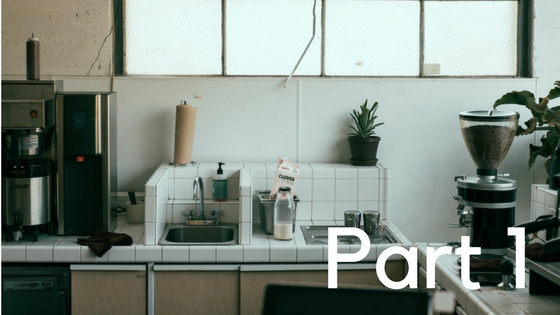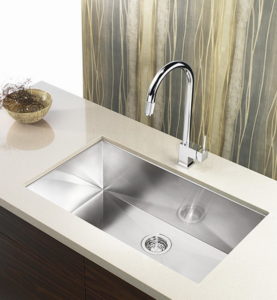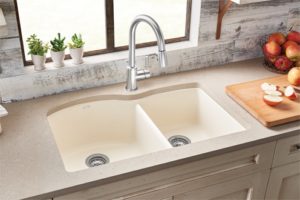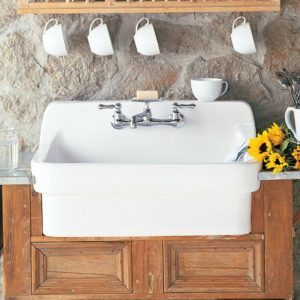One of the busiest, if not THE busiest place in your house is your kitchen sink.
It’s a hard-working space with constant use and lots of abuse with things hot and cold being thrown at it all day long.
The choices for kitchen sinks are vast and can be a bit over-whelming. There is a myriad of materials not to mention all the different shapes, configurations, and styles to choose from.
If you’re finding it mind-boggling to choose between them, let us help you out. We’ve gathered information on each type of kitchen sink and paired it with a pros and cons list so you can compare apples to apples and make an informed decision.
Choosing a Sink Material
Stainless steel
Available in different thicknesses called gauges. The lower the number the thicker and better the stainless steel. Choose between 16 (best), 18 (better) or 20 gauge.
Select at least an 18 gauge kitchen sink to avoid future dents and dings. If your budget allows you to purchase a 16 gauge sink you’ll have a sink with improved durability and one with noticeable sound-deadening qualities. Knock on the bottom of the sinks in a showroom to discover what we mean.
Thinner stainless steels such as 20 gauge will cost less, but this lower quality steel may lead to denting and more noticeable scratching. 18 gauge stainless-steel won’t dent or scratch as easily.
Pros:
- Stainless steel is durable, easy-to-clean and is more forgiving on dropped dishes than solid material sinks
- It’s available in a wide range of configurations, styles and basin shapes such as rectangular, round, or contoured
- Its chameleon-like qualities will blend into and work with many different décor styles, be it traditional or modern
Cons:
- It can and will scratch but the marks can be buffed out of brushed stainless steel, or you can just leave them to blend into a lovely natural patina. Consider purchasing a grid (wire protector) or sink mat to protect the bottom surface of your sink. TIP: Many manufacturers offer multiple sink accessories.
Stone Composite
Crushed granite or quartz are the stones used to create a composite sink. They’re made up of around 80 percent rock and 20 percent resin, which acts as a binding agent.
This combination produces a material that has many of the same aesthetic qualities of real granite or quartz without the maintenance of natural stone.
Pros:
- Both varieties of composite sinks are tough and highly resistant to stains and scratching, but as a general rule granite tends to hold up better than quartz. In fact, some manufacturers claim that granite composite sinks are the most durable and long-lasting sinks available.
- Both have a wide range of sink styles and fade-proof colors and are available for top or under-mount installation
- They offer a more contemporary feel but are available as apron fronts for more traditional decor
- It’s possible to buff away any scratches
Cons:
- Not available in the pattern variations of natural stone slabs, and only available in a matte finish (not glossy or polished)
- Be careful of extremely hot pans as they may damage the finish
- Shop around, as prices vary for similar colors between manufacturers
For a closer look at these types of sinks check out Quartztone granite by Houzer and Canadian made Sil Granite by Blanco.
Porcelain over cast-iron
These sinks are created with a cast iron core covered by a baked-on porcelain finish.
It’s a traditional material that looks wonderfully authentic in kitchens with a vintage style or classic décor.
Pros:
- Wide range of color choice
- Porcelain over cast-iron sinks are extremely durable, and because the iron can be easily molded, this type of sink is available in many shapes, sizes and mounting options
- This type of sink retains heat, making dishwashing more efficient as the water stays hot longer
- The surface of this type of sink can be buffed to a high shine, helping camouflages water spots
- It’s able to be refinished
Cons:
- Porcelain sinks can chip and leave a black mark if something heavy falls on them
- Metal pans can also leave black marks or scuffs that are difficult to remove. Placing a stainless steel rack or sink mat in the basin can help protect the surface.
- They tend to stain or discolor over time which is much more noticeable in lighter colors. TIP: Never allow coffee grounds or other acidic materials to sit in the sink and avoid using abrasive cleansers, rough sponges and steel wool to clean them.
- Porcelain sinks are quite heavy, which can make installation a challenge. Larger styles such as farmer’s sinks require a sturdy frame and countertop.
Continued in Part 2……




